Infrastructure sector to unveil stellar job opportunities in post-COVID world

Suneel Wasan
With China facing massive backlash for the COVID-19 pandemic, many global behemoths are forced to look elsewhere to set up their global manufacturing bases. India can also be seen bridging this gap, buoyed by Government interventions to make the country atmanirbhar with initiatives like Startup India and Make In India, at its very core. However, to house such initiatives, best-in-class infrastructure, be it in terms of road, aviation, power, water, port, urban infrastructure etc are absolutely indispensable.
IBEF foretells that the Indian manufacturing sector is anticipated to touch a staggering US$ 1 trillion by 2025 and will contribute to about 25% to its GDP. The implementation of GST has made the country a common market with a GDP of 2.5 US$ along with a population of 1.38 billion people. In fact, the Make In India initiative itself has the potential to push the domestic manufacturing sector to 12-14% growth per annum over the medium term.
While the COVID-19 pandemic has cast a nimbus shadow on the economy in general and the job market, thanks to Make In India, the infrastructure sector has attained prime importance in the eyes of the Government – with the investment of whopping US$ 1.4 trillion on infrastructure during 2019-23 and a cumulative estimated investment of Rs 5,000,000 crore (US$ 750 billion) for railways infrastructure alone between 2018-2030.
Even though the travel and tourism industry has taken a sharp blow due to the worldwide catastrophe, it cannot be discounted that the Indian aviation market witnessed one of the most robust growth metrics over the years. As per a report by IBEF, India has become the third largest domestic aviation market in the world and is expected to overtake the UK to become the third largest air passenger market by 2024. With such a pace of growth, structural capacity will be breached by 2022, or if growth trajectories resumes soon, capacity limits will be brimmed even faster. As the world come to terms with the new normal, possibilities cannot be ignored.
India has become the third largest domestic aviation market in the world and is expected to overtake the UK to become the third largest air passenger market by 2024
As per CAPA’s estimation, India will need between $36bn and $45bn worth of investment in around 55 airports by 2030. The Government is well aware of this magnitude and therefore, in April 2020, it announced plans to build 100 more airports for one billion flyers by 2035, at an estimated cost of $60bn. Given the circumstances, how the industry gears up to address the rising demand is yet to be seen.
Albeit the report was published long before COVID 19 gripped the world. However, as India is emerging as a viable destination for global manufacturing giants, as investment flows in and visitors arrive from intra and inter nations, 100 airports may not be even sufficient. Therefore, as numbers increase, the job market will see a positive turn.
Likewise, online retail or ecommerce has witnessed an impressive jump, owing to the pandemic and social distancing norms. More and more consumers are now preferring to order in items, rather than stepping out. As per IBEF data, rising smartphone and internet penetration, tumbling tariff rates will further propel the growth of the Indian E-commerce market. As per the insights, the market is expected to reach US$ 200 billion by 2026 from US$ 38.5 billion in 2017. Flipkart, Amazon India and Paytm Mall will occupy around 31% of this growth pie.
In fact, smartphone shipments in India is growing at a rate of around 8% year on year and this will make the country the fastest amongst the top 20 smartphone markets in the world. With digital gaining more and more ground by the day, the number of internet users is also projected to rise from 687.62 million as of September 2019 to 829 million by 2021. The growth of the ecommerce sector has also led to the growth of warehouses and other logistics related infrastructure. This, in turn, has opened up allied job markets for the country’s billion.
In April 2020, the Government of India has made a commitment to build roads worth
Rs 15 lakh crore (US$ 212.80 billion) over the next two years
The Government has also undertaken several steps to revitalise the highways and goods carriage infrastructure sector. It has a sound expansion potential. For instance, in April 2020, the Government made a commitment to build roads worth Rs 15 lakh crore (US$ 212.80 billion) over the next two years. Furthermore, in order to widen and refurbish 1.25-lakh km of roads, the Government of India nodded off the launch of Phase-III of its rural road programme Pradhan Mantri Gram Sadak Yojana (PMGSY). PMGSY-III aims to advance 1,25,000 kms of road length over the next five years at a projected cost of Rs 80,250 crore (US$11.48 billion).
In a similar vein, ports and inland waterways remains to be one of the top priorities for the government. Towards this, the Government has ordered the completion of Jal Vikas Marg on the 1,620 km Haldia-Allahabad stretch of river Ganga. Additionally, the 890 km Dhubri-Sadiya connectivity is proposed to be completed by 2022. The initiatives are aligned to reinvigorate economic activities along the river banks.
The Government has ordered the completion of Jal Vikas Marg on the 1,620 km Haldia-Allahabad stretch of River Ganga
To efficiently manage any future pandemic of this scale, the government has proposed to scale up spending on healthcare infrastructure from 1.6 per cent of GDP to 2.6 per cent of GDP. This has huge investment potential and will open the job market for professionals in all allied sectors.
The author is executive director, HR, Egis India





